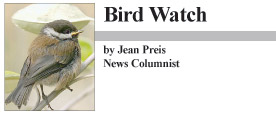Diminutive visitor
 Early morning sunlight gilds the tops of the tall pine trees on the point, pouring molten gold down over their branches. The lake is still in shadow, but as the sun rises higher above the eastern hill, its golden light reaches the far shore, illuminates the forest, and glances off a distant cottage window like a spotlight. As sunlight gradually spreads out across the surface of the lake, the ripples on the water shimmer and dance.
Early morning sunlight gilds the tops of the tall pine trees on the point, pouring molten gold down over their branches. The lake is still in shadow, but as the sun rises higher above the eastern hill, its golden light reaches the far shore, illuminates the forest, and glances off a distant cottage window like a spotlight. As sunlight gradually spreads out across the surface of the lake, the ripples on the water shimmer and dance.
Now, it is light enough to see ducks swimming among the rocks near our shore, and from the comfort of our chairs by the window, with a mug of tea in one hand and binoculars in the other, we can see they are mallards. We sip our tea and wait, watching the day grow brighter. Soon a lone duck appears in another part of the cove. It is smaller than a mallard, and through the binoculars we can see it lacks the mallard’s field marks. The little duck is grayish on the sides and darker on the back, with a bit of white in the wing, and a horizontal patch of white on the side of the face. It is not one of our usual visitors. We look at pictures of ducks in our field guide and discover it is a female bufflehead, a bird we would expect to see along the Maine coast in winter. Later in the day, we check our record of birds seen in the yard and neighborhood, and find it has been six years since we last saw a bufflehead in our cove.
According to the websites of the Cornell Lab of Ornithology, and Birds of North America Online, the bufflehead is the smallest diving duck in North America. It ranges in length from 12.6 inches to 15.7 inches, can have a wingspan of 21.7 inches, and weighs only 9.6 to 22.4 ounces. Our familiar local mallards are considerably larger, up to 25 inches long, with a wingspan up to 37 inches, and weighing as much as 46 ounces. Male buffleheads are predominantly white, with a dark back and face. The entire back of the head is white. Females are grayish on the sides, darker brownish on the back and head, and have an oval shaped white patch on the side of the head below and behind the eye. The name, bufflehead, refers to the bird’s relatively large head, the shape of which reminded early ornithologists of a buffalo’s head.
These diminutive ducks breed in the boreal forest of Canada near small lakes and ponds, where they feed on insects and seeds of aquatic plants. They nest in tree cavities, and because they are small enough to fit into holes excavated by northern flickers, tend to prefer forests of aspen and poplar with a large flicker population. Female buffleheads are faithful to the area where they were hatched, and will even use the same nest site year after year. Unlike most ducks, they are monogamous, staying with the same mate for several years. In the fall, buffleheads migrate to the coast, to spend the winter in shallow saltwater bays and inlets, diving for crustaceans and mollusks.
According to Ralph S. Palmer, author of the 1949 edition of Maine Birds, records show buffleheads were plentiful in Maine in 1875. By 1890 they had become rare because their habit of feeding close to shore made them “one of the principal targets of young gunners.†Maine then began to protect them, and by the 1930s numbers here began to increase, although populations elsewhere remained dangerously low. Over the years, the bufflehead population in Maine continued to increase, and by 1996, when Elizabeth C. Pierson, Jan Erik Pierson, and Peter D. Vickery wrote A Birder’s Guide to Maine, buffleheads were listed as Common to Abundant in Maine, in the winter months.
The beauty of the lake on an early winter morning was not enough to keep our small visitor here. Moments after we saw her she took off, heading in the direction of the coast, where we hoped she might enjoy a shore dinner later in the day.
The Christmas Bird Count will be held Dec. 28, 2011. To learn how to participate, phone 647-2847.

